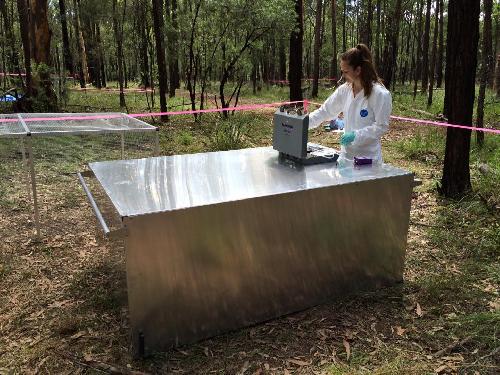London, February 9, 2016 - Rescue workers searching for disaster survivors could use the smell of decomposition to decide what kind of rescue dogs to work with in the hopes of improving their chances of finding survivors. When tragedy strikes and there are casualties, understanding the scent profile of decomposition may help to ensure resources are used in the right way.
New research published in the journal Heliyon reveals the scent profile of decaying pig carcasses during the first 72 hours after death. By analyzing compounds present in decomposition odor, scientists determined that the odor profile changes drastically at the 43-hour mark. Their findings add to a growing body of research on the odor profile of decomposition.
Following a mass disaster, urban search and rescue teams use human scent dogs that are trained to find survivors and human remains detection dogs that are trained to find dead bodies. Knowing the right time to deploy these dogs to look for survivors or remains can be challenging. One way to improve the efficiency of scent detection dogs is to recognize the change in the odor of a recently deceased victim.
 This is an image of the experimental set up the researchers used to sample decomposition odor from pig carcasses. Credit: Shari Forbes
This is an image of the experimental set up the researchers used to sample decomposition odor from pig carcasses. Credit: Shari Forbes
In the new study, researchers from the University of Technology Sydney analyzed the change in the odor of decomposition during the first 72 hours after death. Since pigs are physiologically similar to humans, the authors of the study conducted their research using pig carcasses.
"Our motivation for this study came from information local law enforcement agencies gave us about using scent-detection dogs to help them find living and deceased victims after mass disasters like earthquakes," explained Prue Armstrong, lead author of the study from the University of Technology Sydney.
"We hope our findings give rescue teams the information they need about the optimal time frame in which to deploy human scent dogs versus human remains detection dogs to best ensure the recovery of victims following a mass disaster."
Armstrong and her colleagues placed three domestic pig carcasses on the soil surface during the Australian summer and let them decompose naturally. They sampled the smell coming from the carcasses several times a day as they started to decompose. They used a relatively new technology called "comprehensive two-dimensional gas chromatography - time-of-flight mass spectrometry" (GC×GC-TOFMS) to analyze the odor samples.
The researchers identified 105 volatile organic compounds (VOCs) that contributed to the odor during decomposition. The VOCs they identified belong to several different chemical classes, and the most abundant contained either nitrogen, sulfur or ester compounds.
The make-up of the VOCs changed by the hour, and the odor profile up to 43 hours after death was very different to the odor profile after 43 hours. The researchers believe 43 hours marks the point at which the odor changes from a "living" (antemortem) odor to a "deceased" (postmortem) profile.
"We were quite surprised to be able to identify so many volatile organic compounds during the early postmortem period," said Ms. Armstrong. "We believe this was possible because we used GC×GC-TOFMS to analyze our decomposition odor samples; previous studies using more simple chromatography techniques did not identify as many - or any - VOCs."
The researchers hope they will be helpful for rescue teams in disaster situations, and for other search and rescue scenarios such as the search for lost bushwalkers, or the search for hidden graves. While the findings are preliminary and only relevant to the environmental conditions under which this study was conducted, the researchers have since widened the environmental conditions in which the odor profile is analyzed. The team has conducted another trial of the same format during the Australian winter.
source: Elsevier